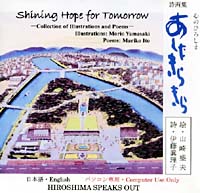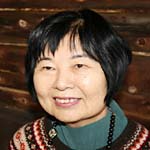"Shining Hope for Tomorrow" by Mariko Ito

|
"Shining Hope for Tomorrow" is the title of a CD that was produced by a citizens' group in Hiroshima called "Hiroshima Speaks Out." The group is involved in translating the accounts of A-bomb survivors into English. The CD contains 102 poems, each with commentary, and includes such poems as "A-bombed Nettle Tree" (Now, we are standing at the place / Where everything starts. / We shall not repeat the evil three times. / This is the starting point of the promise. / The place of the warning to human beings: / Hiroshima) and "First Prefectural Middle School Monument" (Father, Mother, / Please don't lament over / Outliving your son. / I'm together with a lot of friends. / Please remember one thing-- / I was a good boy. / Please never let war break out again). |
No more atomic bomb victims
A shining, hopeful future

|
Mariko Ito
Born in the city of Kitakyushu in 1938. She lived in Hiroshima from 1961 to 2004. In the mid-1980s, she became involved in the anti-nuclear movement with others in literary circles, including the late poet Sadako Kurihara. She now lives in Tokyo.
Many monuments stand in Hiroshima to console the spirits of the A-bomb victims. One poet, Mariko Ito, 72, has written poems about 100 of these monuments and two A-bombed trees, and published an illustrated book of this poetry entitled "Shining Hope for Tomorrow." This book is imbued with her wish that the earth will not be destroyed by war.
The book features a variety of monuments that have been dedicated to people of the A-bombed city and students whose futures were lost in the blast. Ms. Ito was moved by the fact that some of the monuments were built despite the shortage of resources in the post-war period. She felt, "We cannot begin to comprehend the thoughts of the people who built these monuments for the victims. The monuments are invested with their wish that there be no more victims of atomic bombs."
The book was published in 1994. When the late Morio Yamasaki, an illustrator, was drawing pictures of some of the monuments to offer comfort to his father-in-law, who died in the bombing, he asked, through an acquaintance, that Ms. Ito write poems to accompany his illustrations. The book went out of print, but in 2009, the content of the book was reproduced as a CD.
In connection with one of the monuments she wrote about in the book, called the "Students and School Staff Monument," Ms. Ito can't forget one mother's story. She was the mother of a student who attended the Hiroshima Girls' School of Education. Students from that school were mobilized for the war effort and working at a factory on August 6, 1945 when the atomic bomb exploded. Her daughter was among the missing. The mother has kept the nut to a bolt that was produced at the factory, and she has cherished that small nut as a substitute for her daughter's remains.
Many children lost their lives in the atomic bombing. Ms. Ito made an appeal for children today, saying, "I hope you will listen to the people around you, such as your grandparents, about how they lived during the war. And think about what you can do to help build peace."
The poems have all been translated into English. "It's not because I feel a grudge or a need for vengeance," Ms. Ito said. "I want to convey the heart of Hiroshima, the message that the victims of Hiroshima and Nagasaki should be the last victims of nuclear weapons."
The title of the book "Shining Hope for Tomorrow" is derived from her wish "to make the future shining and full of hope" and the way of thinking of the A-bomb survivors in hoping for peace, not vengeance. (Sakiko Masuda, Staff Writer)
|